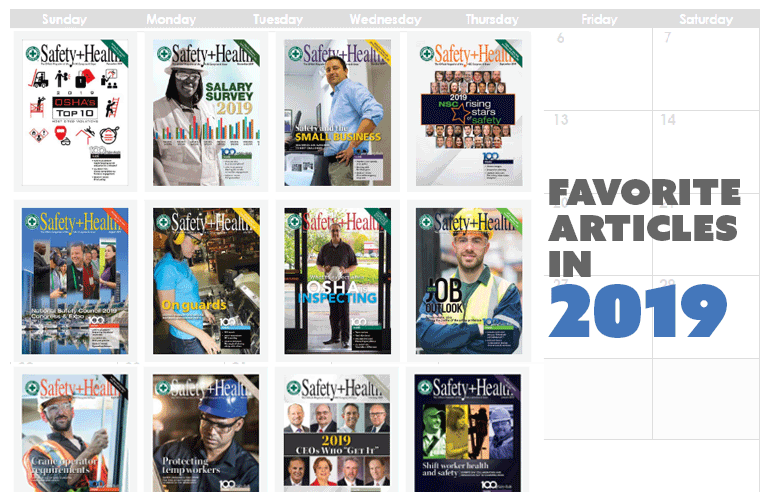Favorite Safety+Health articles in 2019
A workplace safety year-end list

With thousands of articles to choose from and 4.7 million annual pages viewed on the Safety+Health website, readers were most drawn to these 10 occupational safety articles in 2019.
Published in 2019
12019 CEOs Who 'Get It'
Safety+Health presents the National Safety Council’s annual recognition of CEOs who demonstrate a personal commitment to worker safety and health.
2Rising Stars of Safety, Class of 2019
The National Safety Council announces the “Rising Stars of Safety” – safety professionals younger than 40 who have distinguished themselves in the workplace, and who inspire others.
3‘Seeing’ safety in a new way
How can a photo of a leopard help workers spot on-the-job hazards? A concept known as visual literacy aims to help people overcome inattention blindness.
4Clearing the air on marijuana
Rapid legalization, increasing use and conflicting laws are a confusing blend for employers and safety professionals attempting to set workplace policies about marijuana.
Recently published but projected to make the 2019 list
5OSHA’s Top 10 most cited violations for 2019
Safety+Health presents the data on OSHA’s “Top 10” for fiscal year 2019. Also: An exclusive Q&A with Patrick Kapust, deputy director of the agency’s Directorate of Enforcement Programs.
From the archives, remaining popular in 2019
67 common workplace safety hazards
Members of the National Safety Council Consulting Services Group travel across the country – and the world – to visit worksites and conduct safety audits. They share with Safety+Health seven hazards they frequently spot, and offer advice on preventing them.
7 11 tips for effective workplace housekeeping
Good housekeeping is crucial to safe workplaces. Experts agree that all workplaces – from offices to manufacturing plants – should incorporate housekeeping in their safety programs, and every worker should play a part.
8Recognizing hidden dangers: 25 steps to a safer office
A job where most of the work tasks are completed while sitting in a chair in a climate-controlled office building would seem less fraught with danger. However, a surprising number of hazards can be present in an office setting.
9The Hierarchy of Controls
The Hierarchy of Controls helps safety professionals identify and mitigate exposures to on-the-job hazards. “You can’t eliminate every hazard, but the closer you can get to the top, the closer you can reach that ideal and make people healthier and safer,” one expert says.
10Reporting near misses
Observing and abating hazards before someone gets hurt is vital to ensuring worker safety, and a near-miss program can help. Learn what near misses are, how they work, and how to collect reports on them.
Post a comment to this article
Safety+Health welcomes comments that promote respectful dialogue. Please stay on topic. Comments that contain personal attacks, profanity or abusive language – or those aggressively promoting products or services – will be removed. We reserve the right to determine which comments violate our comment policy. (Anonymous comments are welcome; merely skip the “name” field in the comment box. An email address is required but will not be included with your comment.)

